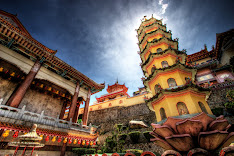Essential Black & White
Posted by Kenny in Published Article on Sunday, February 6, 2005
When photography was first invented, there was only black and white. To this day, black and white photography still captures the interests of many not just because of its nostalgic beginnings. Revisit the works of great photographers like Ansell Adams and you will instantly see why black and white images are still amazing and revered.
What we can discover and interpret from black and white pictures are shapes, forms, light and shadows. In a sense, colour does not become a distracting element and is not essential to the impact of the picture.
There are even times where a picture in black and white may look better than it does in colour. It takes a good eye and a bit of visualisation to see a scene in colour.
In analog photography, black and white films are different in terms of film grain, contrast levels, details of shadows and light. Processing black & white may also require some special treatment during the stage of processing the print to produce a good picture.
Processing a Digital B&W Picture
There are a number of ways to convert your picture into black and white. Although your digital camera may have a black and white setting, I would suggest you don’t use this method as the final outcome may not always be what you want and there is no turning back after the in-camera conversion.
Using software like Adobe Photoshop, you can convert your picture simply by using the “Grayscale” or “Desaturate” tool. It’s simple but this method offers little control over the final results of the picture. The method used here is “Channel Mixing”
Here is a tip before you begin: Create an “adjustment layer” rather than directly altering your picture. Changes using this method are not permanent and you can always go back to the layer and adjust the setting. You can access the adjustment layer by simply clicking on the black and white button at the bottom of the Layer box. You can see an example of this in the conversion described below.
Here is the original picture:
1) Select a new adjustment layer and select Channel Mixer. As you can see this splits your picture into the 3 colour channels, Red, Green and Blue. Sliding the tabs back and forth alters the mix of colours. But now, we will be working with black and white therefore on with the next step.
2) Click on the box below to choose monochrome. You can see that your picture has turned to Black & White. At this point, tweaking the colour sliders with change the shades of different elements in your picture (based on their original colours). You can try different combinations and select what works best for your picture.
3) Instead of using the brightness and contrast, use “Levels” which. To check the contrast of your picture using levels, simply open up a new adjustment layer, and choose layers.
Look at the two ends of the slider. If there are blank spaces on either end, push the slider to the point where the histogram begins to rise. This simply creates “pure” whites or blacks in your picture.
Most of the time, you will need to do this for your picture but as you become better at evaluating your picture, you may sometimes decide not to alter this simply because your picture look better as it is.
| Desaturation vs Channel Mixing In these two pictures you can see the difference between the desaturation method and monochrome channel mixing. The first picture lacks impact. In the second picture, the correct mix of colours in monochrome setting has given the picture a much needed level of contrast and punch. |
Digital Effects
After converting your picture to black and white, you can also add effects to your picture.
1) Adding film grain: You can achieve this by using the “Add Noise” option under the Filter menu. Remember to check the “monochromatic” box at the bottom to create black & white grain.
2) Toning your picture: To tone your picture, again use the adjustment layer and select colour balance this time. Try using a variety of monotone colours. You would be amazed with the effects you can create.
If you have been shooting digitally in colour for a while and feel that your images lack mood, try converting a few to black and white and see how it turns out. You may lease new life into them. I’ll leave you with a few more pictures of subjects that lend themselves well to black & white.

